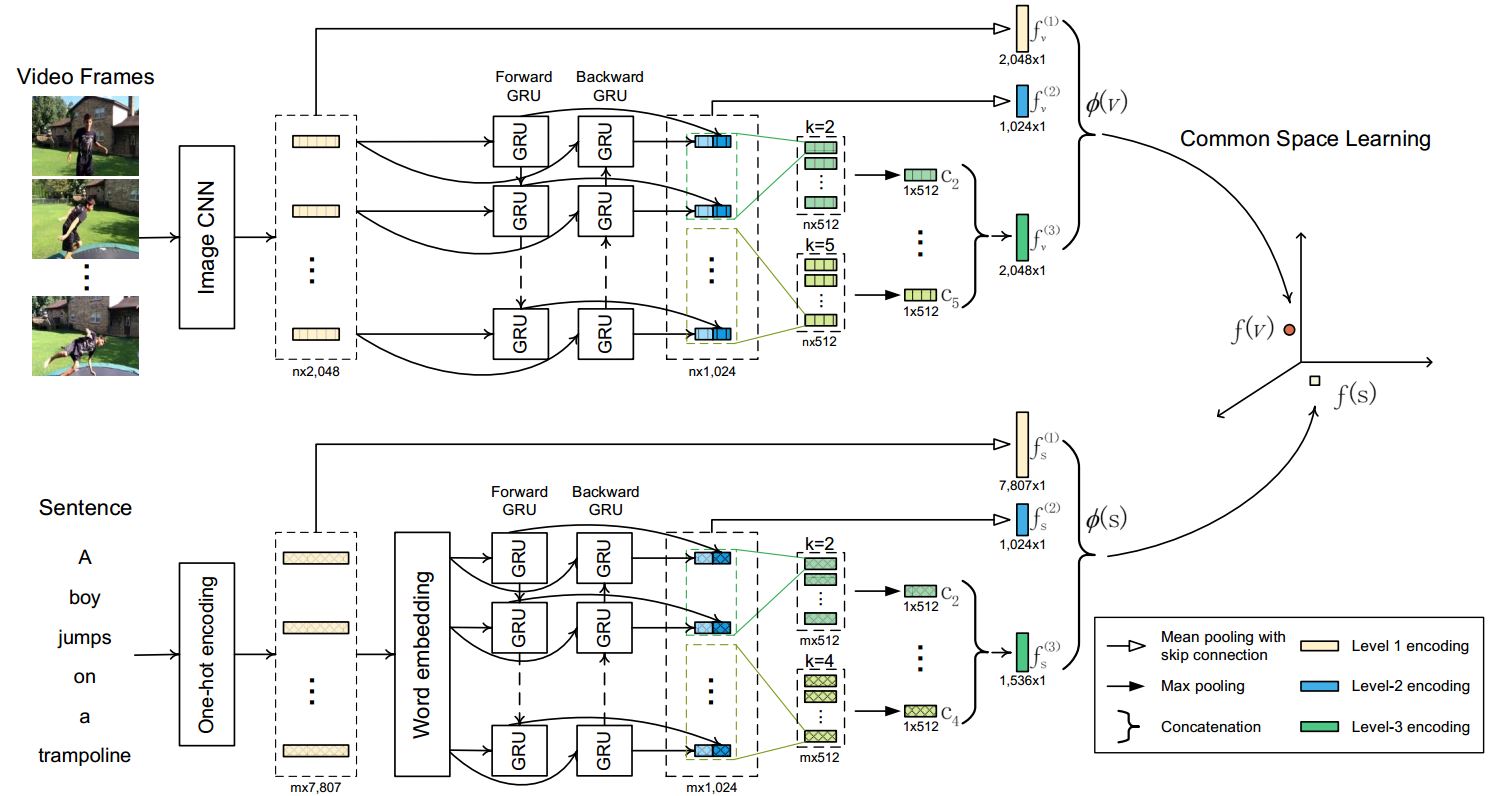Source code of our CVPR'19 paper Dual Encoding for Zero-Example Video Retrieval.
- Ubuntu 16.04
- CUDA 9.0
- Python 2.7
- PyTorch 0.3.1
We used virtualenv to setup a deep learning workspace that supports PyTorch. Run the following script to install the required packages.
virtualenv --system-site-packages -p python2.7 ~/ws_dual
source ~/ws_dual/bin/activate
git clone https://github.com/danieljf24/dual_encoding.git
cd ~/dual_encoding
pip install -r requirements.txt
deactivateRun do_get_dataset.sh or the following script to download and extract MSR-VTT(1.9G) dataset and a pre-trained word2vec(3.0G).
The extracted data is placed in $HOME/VisualSearch/.
ROOTPATH=$HOME/VisualSearch
mkdir -p $ROOTPATH && cd $ROOTPATH
# download and extract dataset
wget http://lixirong.net/data/cvpr2019/msrvtt10k-text-and-resnet-152-img1k.tar.gz
tar zxf msrvtt10k-text-and-resnet-152-img1k.tar.gz
# download and extract pre-trained word2vec
wget http://lixirong.net/data/w2vv-tmm2018/word2vec.tar.gz
tar zxf word2vec.tar.gzThe data can also be downloaded from Google Drive and Baidu Pan.
Run the following script to train and evaluate Dual Encoding network on MSR-VTT.
source ~/ws_dual/bin/activate
./do_all.sh msrvtt10ktrain msrvtt10kval msrvtt10ktest full
deactiveRunning the script will do the following things:
- Generate a vocabulary on the training set.
- Train
Dual Encodingnetwork and select a checkpoint that performs best on the validation set as the final model. Notice that we only save the best-performing checkpoint on the validation set to save disk space. - Evaluate the final model on the test set.
Run the following script to evaluate our trained model(302M) on MSR-VTT.
source ~/ws_dual/bin/activate
MODELDIR=$HOME/VisualSearch/msrvtt10ktrain/cvpr_2019
mkdir -p $MODELDIR
wget -P $MODELDIR http://lixirong.net/data/cvpr2019/model_best.pth.tar
CUDA_VISIBLE_DEVICES=0 python tester.py msrvtt10ktest --logger_name $MODELDIR
deactiveThe expected performance of Dual Encoding on MSR-VTT is as follows. Notice that due to random factors in SGD based training, the numbers differ slightly from those reported in the paper.
| R@1 | R@5 | R@10 | Med r | mAP | |
|---|---|---|---|---|---|
| Text-to-Video | 7.6 | 22.4 | 31.8 | 33 | 0.155 |
| Video-to-Text | 12.8 | 30.3 | 42.4 | 16 | 0.065 |
The following three datasets are used for training, validation and testing: tgif-msrvtt10k, tv2016train and iacc.3. For more information about these datasets, please refer to https://github.com/li-xirong/avs.
Run the following scripts to download and extract these datasets. The extracted data is placed in $HOME/VisualSearch/.
- Sentences: tgif-msrvtt10k, tv2016train
- TRECVID 2016 / 2017 / 2018 AVS topics and ground truth: iacc.3
- 2048-dim ResNeXt-101: tgif(7G), msrvtt10k(2G), tv2016train(42M), iacc.3(27G)
ROOTPATH=$HOME/VisualSearch
cd $ROOTPATH
# download and extract dataset
wget http://39.104.114.128/avs/tgif_ResNext-101.tar.gz
tar zxvf tgif_ResNext-101.tar.gz
wget http://39.104.114.128/avs/msrvtt10k_ResNext-101.tar.gz
tar zxvf msrvtt10k_ResNext-101.tar
wget http://39.104.114.128/avs/tv2016train_ResNext-101.tar.gz
tar zxvf tv2016train_ResNext-101.tar.gz
wget http://39.104.114.128/avs/iacc.3_ResNext-101.tar.gz
tar zxvf iacc.3_ResNext-101.tar.gz
# combine feature of tgif and msrvtt10k
./do_combine_features.sh
source ~/ws_dual/bin/activate
trainCollection=tgif-msrvtt10k
visual_feature=pyresnext-101_rbps13k,flatten0_output,os
# Generate a vocabulary on the training set
./do_get_vocab.sh $trainCollection
# Generate video frame info
./do_get_frameInfo.sh $trainCollection $visual_feature
# training and testing
./do_all_avs.sh
deactiveStore the training, validation and test subset into three folders in the following structure respectively.
${subset_name}
├── FeatureData
│ └── ${feature_name}
│ ├── feature.bin
│ ├── shape.txt
│ └── id.txt
├── ImageSets
│ └── ${subset_name}.txt
└── TextData
└── ${subset_name}.caption.txt
FeatureData: video frame features. Using txt2bin.py to convert video frame feature in the required binary format.${subset_name}.txt: all video IDs in the specific subset, one video ID per line.${dsubset_name}.caption.txt: caption data. The file structure is as follows, in which the video and sent in the same line are relevant.
video_id_1#1 sentence_1
video_id_1#2 sentence_2
...
video_id_n#1 sentence_k
...
You can run the following script to check whether the data is ready:
./do_format_check.sh ${train_set} ${val_set} ${test_set} ${rootpath} ${feature_name}where train_set, val_set and test_set indicate the name of training, validation and test set, respectively, ${rootpath} denotes the path where datasets are saved and feature_name is the video frame feature name.
If you pass the format check, use the following script to train and evaluate Dual Encoding on your own dataset:
source ~/ws_dual/bin/activate
./do_all_own_data.sh ${train_set} ${val_set} ${test_set} ${rootpath} ${feature_name} ${caption_num} full
deactivewhere caption_num denotes the number of captions for each video. For the MSRVTT dataset, the value of caption_num is 20.
If training data of your task is relatively limited, we suggest dual encoding with level 2 and 3. Compared to the full edition, this version gives nearly comparable performance on MSR-VTT, but with less trainable parameters.
source ~/ws_dual/bin/activate
./do_all_own_data.sh ${train_set} ${val_set} ${test_set} ${rootpath} ${feature_name} ${caption_num} reduced
deactiveIf you find the package useful, please consider citing our CVPR'19 paper:
@inproceedings{cvpr2019-dual-dong,
title = {Dual Encoding for Zero-Example Video Retrieval},
author = {Jianfeng Dong and Xirong Li and Chaoxi Xu and Shouling Ji and Yuan He and Gang Yang and Xun Wang},
booktitle = {IEEE Conference on Computer Vision and Pattern Recognition (CVPR)},
year = {2019},
}
